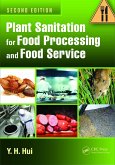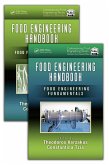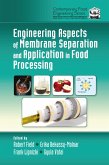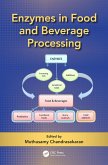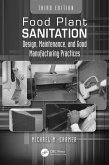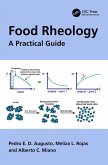

Alle Infos zum eBook verschenken

- Format: PDF
- Merkliste
- Auf die Merkliste
- Bewerten Bewerten
- Teilen
- Produkt teilen
- Produkterinnerung
- Produkterinnerung

Hier können Sie sich einloggen

Bitte loggen Sie sich zunächst in Ihr Kundenkonto ein oder registrieren Sie sich bei bücher.de, um das eBook-Abo tolino select nutzen zu können.
Maintaining the high standard set by the previous bestselling editions, this book presents the most up-to-date information in this rapidly growing and highly dynamic field. Revised and expanded to reflect recent advances, this edition broadens coverage of foodborne diseases to include many new and emerging pathogens, as well as descriptions of the mechanism of pathogenesis. With the inclusion of many more easy-to-follow figures and illustrations, this text provides a comprehensive introductory source for undergraduates, as well as a valuable reference for graduate level and working professionals in food microbiology or food safety.…mehr
- Geräte: PC
- ohne Kopierschutz
- eBook Hilfe
- Größe: 20.04MB
![Fundamental Food Microbiology (eBook, PDF) Fundamental Food Microbiology (eBook, PDF)]() Bibek RayFundamental Food Microbiology (eBook, PDF)100,95 €
Bibek RayFundamental Food Microbiology (eBook, PDF)100,95 €![Plant Sanitation for Food Processing and Food Service (eBook, PDF) Plant Sanitation for Food Processing and Food Service (eBook, PDF)]() Y. H. HuiPlant Sanitation for Food Processing and Food Service (eBook, PDF)248,95 €
Y. H. HuiPlant Sanitation for Food Processing and Food Service (eBook, PDF)248,95 €![Food Engineering Handbook, Two Volume Set (eBook, PDF) Food Engineering Handbook, Two Volume Set (eBook, PDF)]() Food Engineering Handbook, Two Volume Set (eBook, PDF)336,95 €
Food Engineering Handbook, Two Volume Set (eBook, PDF)336,95 €![Engineering Aspects of Membrane Separation and Application in Food Processing (eBook, PDF) Engineering Aspects of Membrane Separation and Application in Food Processing (eBook, PDF)]() Engineering Aspects of Membrane Separation and Application in Food Processing (eBook, PDF)201,95 €
Engineering Aspects of Membrane Separation and Application in Food Processing (eBook, PDF)201,95 €![Enzymes in Food and Beverage Processing (eBook, PDF) Enzymes in Food and Beverage Processing (eBook, PDF)]() Enzymes in Food and Beverage Processing (eBook, PDF)90,95 €
Enzymes in Food and Beverage Processing (eBook, PDF)90,95 €![Food Plant Sanitation (eBook, PDF) Food Plant Sanitation (eBook, PDF)]() Michael M. CramerFood Plant Sanitation (eBook, PDF)51,95 €
Michael M. CramerFood Plant Sanitation (eBook, PDF)51,95 €![Food Rheology (eBook, PDF) Food Rheology (eBook, PDF)]() Pedro E. D. AugustoFood Rheology (eBook, PDF)85,95 €
Pedro E. D. AugustoFood Rheology (eBook, PDF)85,95 €-
-
-
Dieser Download kann aus rechtlichen Gründen nur mit Rechnungsadresse in A, B, BG, CY, CZ, D, DK, EW, E, FIN, F, GR, HR, H, IRL, I, LT, L, LR, M, NL, PL, P, R, S, SLO, SK ausgeliefert werden.
- Produktdetails
- Verlag: Taylor & Francis
- Seitenzahl: 663
- Erscheinungstermin: 26. November 2013
- Englisch
- ISBN-13: 9781466564442
- Artikelnr.: 57895933
- Verlag: Taylor & Francis
- Seitenzahl: 663
- Erscheinungstermin: 26. November 2013
- Englisch
- ISBN-13: 9781466564442
- Artikelnr.: 57895933
- Herstellerkennzeichnung Die Herstellerinformationen sind derzeit nicht verfügbar.
Arun K. Bhunia, BVSc, PhD, is a professor of molecular food microbiology in the Department of Food Science and also in the Department of Veterinary Comparative Pathobiology (Courtesy) at Purdue University, West Lafayette, Indiana. Professor Bhunia received his bachelor of veterinary medicine degree (1984) from Bidhan Chandra Krishi Viswa Vidyalaya (currently West Bengal University of Fisheries and Animal Sciences), West Bengal, India. He received his PhD (1989) from the University of Wyoming (USA) under the mentorship of Professor Bibek Ray and postdoctoral training (1995) from the University of Arkansas, Fayetteville, under the mentorship of Prof. Michael G. Johnson and then joined Alabama A&M University (Normal, Alabama) as an assistant professor in 1995. In 1998, he joined the Department of Food Science at Purdue University. He teaches three graduate level courses: Microbial Foodborne Pathogens (major topics: Mechanism of pathogenesis of foodborne pathogens and toxins and the host-parasite interactions); Microbial Techniques for Food Pathogen (a laboratory course that incorporates rapid methods employing immunoassays and genetic and biosensor tools), and codirects a graduate level journal club, Intestinal Microbiology and Immunology. In addition, he routinely lectures in courses such as Principles of Public Health (both undergraduate and graduate levels) on foodborne diseases, and Veterinary Microbiology and Mycology on several foodborne pathogens. Professor Bhunia's laboratory maintains a balanced research program (basic and applied) to address problems related to foodborne pathogens in the following areas: (a) pathogen and toxin detection; (b) understanding the mechanism of pathogenesis of enteric pathogens, including Listeria monocytogenes; and (c) application of bioengineered probiotics and natural antimicrobial peptides coupled with nanotechnology to control pathogens. His research has been funded by grants from the U.S. Department of Agriculture, National Science Foundation, National Cattleman's Beef Association, National Institute of Health, and Center for Food Safety Engineering.
Food Microbiology. Characteristics of Predominant Microorganisms in Food.
Sources of Microorganisms in Foods. Normal Microbiological Quality of Foods
and Its Significance. SECTION II: MICROBIAL GROWTH RESPONSE IN THE FOOD
ENVIRONMENT. Microbial Growth Characteristics. Factors Influencing
Microbial Growth in Food. Microbial Attachments and Biofilm Formation.
Microbial Metabolism of Food Components. Microbial Sporulation and
Germination. Microbial Stress Response in the Food Environment. SECTION
III: BENEFICIAL US ES OF MICROORGANISMS IN FOOD. Microorganisms Used in
Food Fermentation. Biochemistry of Some Beneficial Traits. Genetics of Some
Beneficial Traits. Starter Cultures and Bacteriophages. Microbiology of
Fermented Food Production. Intestinal Bacteria and Probiotics. Food
Biopreservatives of Microbial Origin, Bacteriocin, and Nanotechnology. Food
Ingredients and Enzymes of Microbial Origin. SECTION IV: MICROBIAL FOOD
SPOILAGE. Important Factors in Microbial Food Spoilage. Spoilage of
Specific Food Groups. New Food Spoilage Bacteria in Refrigerated Foods.
Food Spoilage by Microbial Enzymes. Indicators of Microbial Food Spoilage.
SECTION V: MICROBIAL FOODBORNE DISEASES. Important Facts in Foodborne
Diseases. Foodborne Intoxications. Foodborne Bacterial Infections.
Foodborne Toxico-Infections. Opportunistic Bacterial Pathogens, Molds and
Mycotoxins, Viruses, Parasites,. and Fish and Shellfish Toxins. New and
Emerging Foodborne Pathogens. Indicators of Bacterial Pathogens. SECTION
VI: CONTROL OF MICROORGANISMS IN FOODS. Control of Access of
Microorganisms: Cleaning, Sanitation, and Disinfection. Control by Physical
Removal. Control by Heat (Thermal Processing). Control by Low Temperature.
Control by Reduced Water Activity and Drying. Control by Low pH and Organic
Acids. Control by Modified Atmosphere (or Reducing O-R Potential). Control
by Antimicrobial Preservatives and Bacteriophages. Control by Irradiation.
Control by Novel Processing Technologies. Control by a Combination of
Methods (Hurdle Concept). SECTION VII: MICROBIAL DETECTION AND FOOD SAFETY.
Conventional, Immunological, Molecular, and Biosensor-Based Detection
Methods. Appendix A: Predictive Modeling of Microbial Growth in Food.
Appendix B: Regulatory Agencies Monitoring Microbiological Safety of Foods
in the United States. Appendix C: Hazard Analysis Critical Control Points.
Index.
Food Microbiology. Characteristics of Predominant Microorganisms in Food.
Sources of Microorganisms in Foods. Normal Microbiological Quality of Foods
and Its Significance. SECTION II: MICROBIAL GROWTH RESPONSE IN THE FOOD
ENVIRONMENT. Microbial Growth Characteristics. Factors Influencing
Microbial Growth in Food. Microbial Attachments and Biofilm Formation.
Microbial Metabolism of Food Components. Microbial Sporulation and
Germination. Microbial Stress Response in the Food Environment. SECTION
III: BENEFICIAL US ES OF MICROORGANISMS IN FOOD. Microorganisms Used in
Food Fermentation. Biochemistry of Some Beneficial Traits. Genetics of Some
Beneficial Traits. Starter Cultures and Bacteriophages. Microbiology of
Fermented Food Production. Intestinal Bacteria and Probiotics. Food
Biopreservatives of Microbial Origin, Bacteriocin, and Nanotechnology. Food
Ingredients and Enzymes of Microbial Origin. SECTION IV: MICROBIAL FOOD
SPOILAGE. Important Factors in Microbial Food Spoilage. Spoilage of
Specific Food Groups. New Food Spoilage Bacteria in Refrigerated Foods.
Food Spoilage by Microbial Enzymes. Indicators of Microbial Food Spoilage.
SECTION V: MICROBIAL FOODBORNE DISEASES. Important Facts in Foodborne
Diseases. Foodborne Intoxications. Foodborne Bacterial Infections.
Foodborne Toxico-Infections. Opportunistic Bacterial Pathogens, Molds and
Mycotoxins, Viruses, Parasites,. and Fish and Shellfish Toxins. New and
Emerging Foodborne Pathogens. Indicators of Bacterial Pathogens. SECTION
VI: CONTROL OF MICROORGANISMS IN FOODS. Control of Access of
Microorganisms: Cleaning, Sanitation, and Disinfection. Control by Physical
Removal. Control by Heat (Thermal Processing). Control by Low Temperature.
Control by Reduced Water Activity and Drying. Control by Low pH and Organic
Acids. Control by Modified Atmosphere (or Reducing O-R Potential). Control
by Antimicrobial Preservatives and Bacteriophages. Control by Irradiation.
Control by Novel Processing Technologies. Control by a Combination of
Methods (Hurdle Concept). SECTION VII: MICROBIAL DETECTION AND FOOD SAFETY.
Conventional, Immunological, Molecular, and Biosensor-Based Detection
Methods. Appendix A: Predictive Modeling of Microbial Growth in Food.
Appendix B: Regulatory Agencies Monitoring Microbiological Safety of Foods
in the United States. Appendix C: Hazard Analysis Critical Control Points.
Index.


